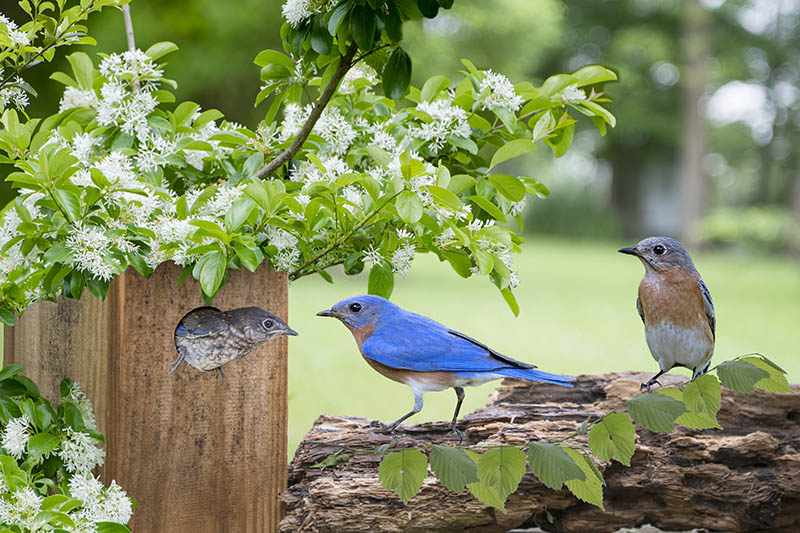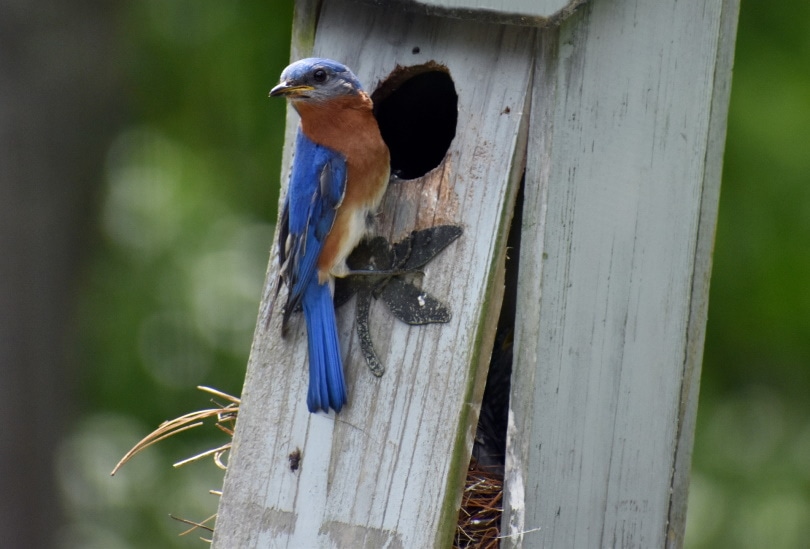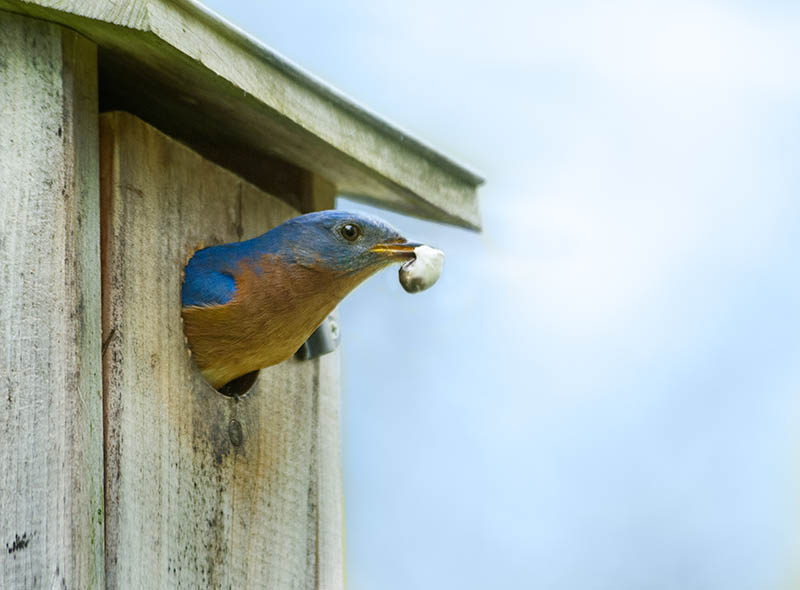Where to Place Bluebird Houses (7 Ideal Locations)
Last Updated on

Bluebirds are a highly sought-after species for birdwatchers due to their extraordinary colors, and many dedicated enthusiasts want to give them a home so they can be seen from afar. You can place a bluebird house in several areas, but some will work better than others. In this article, we’ll show you seven ideal locations you can put houses, as well as why they make such a good location for bluebirds to settle in!

Before You Install a Bluebird House
One thing to note before you build and set up your bluebird home is that they should ideally face the east since the heat from the sun during the afternoon can be uncomfortable to the birds while they rest in their nests.
If you have a lot of house sparrows that live nearby, we recommend that you look for another area. They are known to pester and ruin the nests of other birds. Now, on to the fun part!
Top 7 Places to Put a Bluebird House:
1. Open Grasslands
| Our Rating: | 5/5 |
The best location for a bluebird house is in an open, grassy field. These areas have little to no shade, and the bluebirds can enjoy lots of sunlight. Additionally, there aren’t any houses or buildings nearby, and it’s unlikely that house sparrows or other pests will try to invade your bluebird’s home. The more open your area is, the better the chance of attracting bluebirds. However, it would be wise to put it within a reasonable distance of a few trees where they can enjoy the shade or forage for food.
- Open area
- Plenty of sunlight
- Less common in the Eastern U.S

2. Farmlands and Pastures
| Our Rating: | 4/5 |
With such a large amount of land to cover and little to no trees or obstructions, farmlands are perfect places for you to install a bluebird house. Attaching a house to a fence post might be the way to go, but be cautious since snakes or rodents may be able to access the structure. Don’t forget to ask permission of the landowner if you want to put it on private land.
- Open area
- Plenty of sunlight
- You need permission if it isn’t on your property
- Other birds could be nearby

3. Golf Course
| Our Rating: | 3.5/5 |
A golf course is a perfect setting for bluebirds to live since there is so much wide-open space with mowed grass. Usually, golf courses have trees and bushes scattered around, which are excellent to have for the bluebirds to fly back and forth. One big issue with using a golf course is that if it is active, the house could be hit by a golf ball. If this were to happen, it could have terrible consequences for any eggs or baby birds inside. Abandoned or out-of-season golf courses are your best bet. In either case, it’s best to place your house near the tree line (but still distant from it) and behind or to the sides of the golfer’s tee.
- Perfectly spaced environment
- Tons of mowed grass
- The possibility of golf balls interfering
- Requires permission from the golf course owner
4. Baseball Field
| Our Rating: | 3/5 |
Like golf courses, baseball fields are ideal environments with lots of space for bluebirds to fly around. You should place them in an unused or abandoned baseball field, as we mentioned with the golf course so that you don’t return to a shattered bluebird house. If it is in use, you may be able to put it to the side of the field if there is still some open area. Try to keep it away from the dugouts or snack stands since those areas will repel bluebirds.
- Open area
- Grassy
- Can be risky if the field is being used
- You may not be able to use the field for this purpose
- Buildings nearby

5. Recreational Parks
| Our Rating: | 3.5/5 |
Local parks are such a blessing for local residents, and they are fit for a bluebird house or even a trail of houses! If possible, try to place them in parks that aren’t as popular for people to walk their dogs since busy areas may scare the species away. Parks often have wide-open fields for people to relax and enjoy the outdoors, and they are ideal locations to set up a birdhouse. If there is a massive space like a field, place your bluebird home as far away from the walking trail as you can and closer to the tree line. That way, there won’t be much interference from people who want to use the area, and you’ll still get the benefits!
- Public use area
- Decent spacing
- Dogs may deter bluebirds if too close
- Low-traffic areas are best

6. Open Woodlands
| Our Rating: | 5/5 |
The natural habitats of a bluebird mainly consist of open grasslands or open woodlands. Open woodlands have all the necessities the species needs to survive and appropriate space and privacy from humans or buildings. A clever location for the birdhouse or birdhouse trail is hiking or walking trails. You should place the house in an area where people won’t disturb the birds’ daily routines.
- It’s their natural habitat
- Open area for them to fly around
- You’ll need to search for areas balanced with shade and trees

7. Near the Forest of Your Lawn or Backyard
| Our Rating: | 4/5 |
The place we realistically have available to build and stake out a birdhouse is behind our homes. Depending on how your property is set up, you might be able to set up a bluebird house easily, as long as it is a couple of hundred feet from your house. The ideal property has a spacious lawn and a few bushes or scattered trees for birds to enjoy. Remember to keep the house away from the road.
- Easily available
- Somewhat open
- An active household may disturb the birds
- Not everyone has a large backyard or lawn
- House sparrows may be pests


Final Thoughts
Bluebirds are elegant birds, but they have a quirky habitat preference which can make it a challenge for people to create their own bluebird trails. The best way to help is to search your local area for open spaces that might have the right setting for the birds to thrive, but remember to get permission when you visit private property. We hope these seven locations provide insight so you can spot the bluebirds in no time!
Featured Image Credit: Bonnie Taylor Barry, Shutterstock
About the Author Robert Sparks
Robert’s obsession with all things optical started early in life, when his optician father would bring home prototypes for Robert to play with. Nowadays, Robert is dedicated to helping others find the right optics for their needs. His hobbies include astronomy, astrophysics, and model building. Originally from Newark, NJ, he resides in Santa Fe, New Mexico, where the nighttime skies are filled with glittering stars.
Related Articles:
10 Types of Hummingbirds in Arkansas (With Pictures)
8 Types of Hummingbirds in Nebraska (With Pictures)
5 Types of Hummingbirds in Idaho (With Pictures)
3 Types of Hummingbirds in Mississippi (With Pictures)
8 Types of Hummingbirds in Kansas (With Pictures)
5 Types of Hummingbirds in West Virginia (With Pictures)
5 Types of Hummingbirds in Ohio (With Pictures)
Where Do Nuthatches Nest? Nuthatch Nesting Habits Explained
